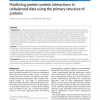Free Online Productivity Tools
i2Speak
i2Symbol
i2OCR
iTex2Img
iWeb2Print
iWeb2Shot
i2Type
iPdf2Split
iPdf2Merge
i2Bopomofo
i2Arabic
i2Style
i2Image
i2PDF
iLatex2Rtf
Sci2ools
102
click to vote
BMCBI
2010
2010
Predicting protein-protein interactions in unbalanced data using the primary structure of proteins
Background: Elucidating protein-protein interactions (PPIs) is essential to constructing protein interaction networks and facilitating our understanding of the general principles of biological systems. Previous studies have revealed that interacting protein pairs can be predicted by their primary structure. Most of these approaches have achieved satisfactory performance on datasets comprising equal number of interacting and non-interacting protein pairs. However, this ratio is highly unbalanced in nature, and these techniques have not been comprehensively evaluated with respect to the effect of the large number of non-interacting pairs in realistic datasets. Moreover, since highly unbalanced distributions usually lead to large datasets, more efficient predictors are desired when handling such challenging tasks. Results: This study presents a method for PPI prediction based only on sequence information, which contributes in three aspects. First, we propose a probability-based mechanism...
Related Content
| Added | 12 May 2011 |
| Updated | 12 May 2011 |
| Type | Journal |
| Year | 2010 |
| Where | BMCBI |
| Authors | Chi-Yuan Yu, Lih-Ching Chou, Darby Tien-Hao Chang |
Comments (0)

